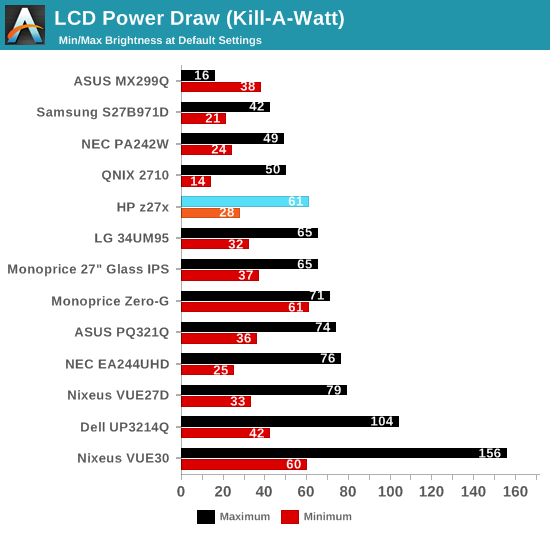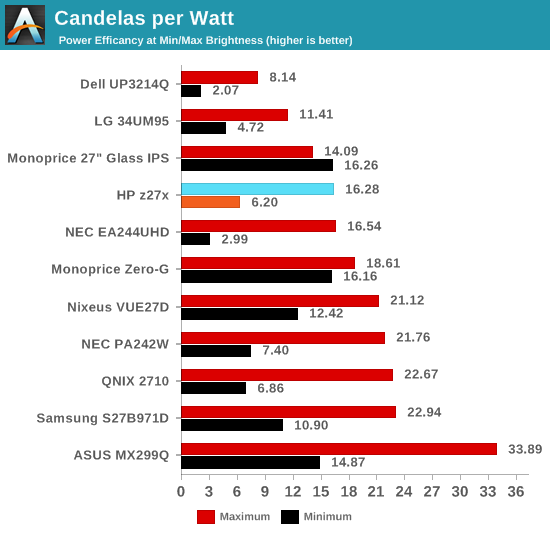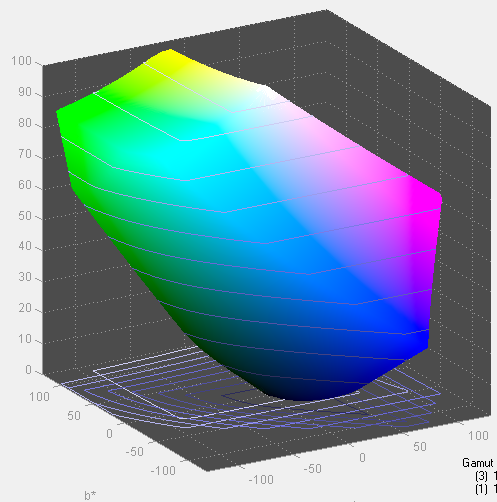HP z27x Review
by Chris Heinonen on December 2, 2014 4:00 PM ESTLag is measured using the Leo Bodnar lag tester. It uses 1080p over HDMI so it cannot run at the native resolution. The HP z27x does let you turn the scaler on and off, letting you use a 1:1 pixel mode, so I can attempt to see what impact the scaler makes.
In 1:1 pixel mapping, the input lag is 33ms. Considering there is a 3D LUT in the display, this performance is pretty good. It is still two full frames in a 60fps game, but it might be acceptable to people. Turning on the scaler adds 1.5ms of lag, which is completely inconsequential. Most people will want to run content at the native resolution but if you have to scale it you will see virtually no impact when it comes to lag.

We covered the different gamut options for the HP z27x earlier, but it has a very large gamut in native mode. It does 152.1% of the AdobeRGB gamut, easily the best we have ever measured. If you need to work in larger color gamuts like DCI, the HP z27x has you covered.

At maximum power, the HP z27x uses 61 watts of power and at minimum it uses 28 watts. Both of these numbers are average looking at other 27” monitors, but considering the other features this is quite good. The backlight can produce a very wide gamut and thankfully it doesn’t have to consume extra power in order to do so.













47 Comments
View All Comments
SanX - Sunday, December 7, 2014 - link
The author has done absolutely right things. HP indeed does not care even to cherrypick. HPs and Dells became more and more a rebranders of Chinese goods. And actually it is not the China the final reason in bad quality control of everything but WE THE BRAINDEAD PEOPLE and of course our croocky american sales/middlemen who exploit this vulnerability of average technically illiterate Joe and are just interested to drop more larger margin shiny crap on the heads of dumb public, on our heads.DanNeely - Tuesday, December 2, 2014 - link
It might've been the 1st time it crossed your desk; but NEC's offered in monitor calibration since (at least) the the Multysync 3090 (released around 2008). I'm not sure how it compares with HP's offering; but they've got something called NaViSet to allow centralized admin of display settings. Lastly, IIRC their internal calibration does have some ability to adjust for uneven backlighting (presumably at the cost of some overall contrast).http://www.necdisplay.com/support-and-services/nav...
cheinonen - Wednesday, December 3, 2014 - link
I've used and reviewed the NEC PA series, and while they offer an internal LUT with calibration options, it has to be done through the SpectraView II software. The HP allows you to do it entirely inside the display without a PC at all, making it easier to do a large number of them. The NEC PA series also lacks the Ethernet control. The uniformity on the NECs is top notch.baii9 - Tuesday, December 2, 2014 - link
Wide gamut -> GB-r LED -> uniformity issue, why am I not surprised.Here is when good warranty kick in, panel lottery.
Doomtomb - Tuesday, December 2, 2014 - link
This monitor came out in 2014? This looks like something that would've come out in 2009. The bezel is huge. The body is thick. The resolution is nothing special. I don't care if it has features, and the color gamut. Seriously, this is the mind of the average consumer.D. Lister - Tuesday, December 2, 2014 - link
This product isn't targeted at the average consumer.DanNeely - Wednesday, December 3, 2014 - link
Although one of the reasons why pro-grade monitors tend to be significantly thicker than consumer ones is to put an array of evenly spaced backlights behind the panel instead of just a few on one or more edges using mirrors to bounce it around; because the former results in more even illumination.Something that clearly didn't happen with this monitor; and since AT has proven willing to hold reviews if they see unexpectedly bad results and the vendor says "looks like something broke, let us send you a replacement to test" or "we didn't test that case and need to write a new firmware to fix the problem" I can only assume that HP considers the level of backlight variation Chris saw in this model acceptable.
kyuu - Thursday, December 4, 2014 - link
Based on Chris's own statement in these comments, your assumption would be wrong. It seems that Chris didn't inform HP or offer them the chance to send a replacement in order to avoid the appearance of receiving a "cherry picked" sample.... Seems kinda silly to me. Unless Chris purchased the review unit himself, HP already had the chance to submit a cherry picked sample. Giving them the chance to fix what may very well be damage incurred during shipping does not somehow break reviewer ethics.
baii9 - Wednesday, December 3, 2014 - link
average consumer don't drop 1.4k on a 27" monitor.jann5s - Wednesday, December 3, 2014 - link
The ASUS MX229Q is using more power at minimum then at maximum, I guess there is a booboo in the database (LCD Power Draw figure)